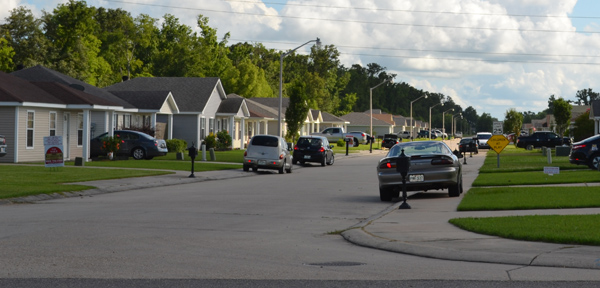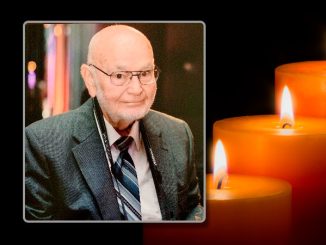
Says taxpayers must foot bill of neighborhood repairs, but parish president disputes charges
Councilman Paul Hogan says Parish President V.J. St. Pierre did not properly carry out his duties when he didn’t challenge the warranty of a donated neighborhood in a move that may eventually cost taxpayers thousands of dollars.
Hogan points to a 2008 parish ordinance that says the developers of a neighborhood must make repairs to the area before the parish accepts the donated property. He says the rules of the ordinance were not followed after a parish report showed the second phase of the Hidden Oaks neighborhood in Luling had significant concrete problems that will eventually have to be repaired.
“Everything that was wrong with it when they did the report is still there. Barricades are still improper, signs are still low and slab panels are cracked,” Hogan said. “Right now, water is running into the concrete base. Now the parish is going to put off repairs for as long as they can, but it should have been the developer doing the repairs and the parish taking it over with the repairs made.”
The donated subdivision was built five years ago by JJJ Development Partners, LLC., which is owned by St. Charles Parish District Attorney Joel Chaisson and former councilman Jay Roberts. The subdivision was not donated until February 2012 when it became the first subdivision to be donated after the ordinance was passed.
The donation of a subdivision to the parish occurs when developers build all necessary infrastructure, such as roadways, utility hookups and signage, and then turn it over to the parish for maintenance once home construction begins on individual lots.
Hogan sponsored the ordinance that mandated inspections be done at least two weeks prior to the expiration of the one year warranty period that is in place following dedication. Included in that inspection is the requirement of a checklist, also known as a “punch list,” of infrastructure items to be evaluated.
With the warranty set to expire in February, the Hidden Oaks inspection was completed in January and noted that concrete poured throughout the subdivision did not meet any of the required standards and was deteriorating. Included in the report were photos showing gaps between concrete slabs, deteriorating concrete, structural cracks in the roadway as well as other problems.
In addition, roadway signs were placed at the wrong height and a dead end on the property was improperly marked.
According to Hogan, the developers had time after the inspection to make the repairs indicated in the report, but those repairs were never made because the parish administration did not follow inspection protocol as laid out in the ordinance by making the developer sign off on the report.
Additionally, Hogan said he warned St. Pierre of the need for repairs at the development, but nothing was done.
“I brought it to the attention of the administration before the warranty expired and all they had to do was follow the simple rules of the ordinance and the developer would have had to take care of these issues,” he said.
St. Pierre denied Hogan’s assertion and said most of the repairs listed in the inspection report had been made.
“Everything on the punch list, except for two cracks, has been done,” he said.
Hogan maintains that no repairs were made between the acceptance of the neighborhood’s dedication and the expiration of the warranty.
“I think right now V.J. is basing his information on what he is getting from others and V.J. might not know or may not be getting proper or accurate information,” Hogan said. “When I went riding through I saw that the damage is still there. The major item is broken cement slabs. Every broken slab that I saw in those pictures is still broken today.”
In fact, concrete in the neighborhood does show signs of deterioration and at least one of the signs is still hung incorrectly and others are at lower heights than required.
Sam Scholle, St. Charles Parish Public Works director, said because the donation was accepted five years following its construction it did not have to meet the standards of a newly constructed subdivision.
“The parish council accepted this neighborhood in the condition that it was in. If something drastic would have happened between the dedication and the expiration of the warranty, such as a huge pothole forming in the middle of the street, we would have had it fixed. But the street is in exactly the same condition as the day it was dedicated,” he said.
Scholle said other developments that were constructed during the same time period are now showing more severe structural problems than the second phase of Hidden Oaks has.
“I wish all of our streets in the parish that are this old looked like this (Hidden Oaks),” he said.
Hogan said while deterioration of roadways is common in donated developments, properties should meet the inspection standards under the 2008 ordinance.
“Why they waited three years to dedicate it I have no clue, but they didn’t dedicate it at that time. Over time things settle, things crack and you are taking that risk if you do not dedicate it towards the beginning,” he said.
Hogan reiterated that the warranty covered in his ordinance requires the donation to pass a standard inspection without taking into account the age of the property.
“You’ve got a 12 month warranty from the day it is taken and not a 12 month warranty from the condition it is in when you accept the dedication. The ordinance doesn’t say that. The slab, the light post, everything needs to meet parish code and if it doesn’t meet parish code he has to fix it,” he said.
Hogan is a civil engineer who formerly worked for RJM Enterprises, owned by his uncle Ray Matherne, for whom he helped develop numerous subdivisions throughout the parish.
He said the entire reason he became a councilman was because he felt former parish governments were showing favoritism in applying parish law regarding developments.
“It happened to be that this company I worked for was held to the tee every time. If you were one of these other companies you were not held to the same standards. You could get away with it. That’s why I fixed these codes. It ain’t black, it ain’t grey – it’s either black or it’s white. You either meet or don’t meet it,” Hogan said.
Hogan is in the process of requesting a special report on the Department of Public Works’ actions concerning the provisions of the ordinance requiring the inspection.




Be the first to comment